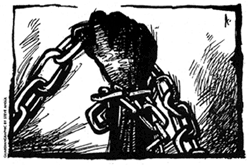By John Hutton

Sunday, August 10th, marked the 40th anniversary of what has come to be known as Prisoners’ Justice Day in Canada. Ever since the suicide of Edward Nolan in a segregation cell at Milhaven Institution on this date back in 1974, Canadians have held a vigil to remember all who have died while incarcerated. Many prisoners fast and decline to work on that day while those outside the prison walls renew the call for changes to the correctional system.
This year, the anniversary is a sombre one as we seem to be moving backwards at an ever increasing rate, undoing many of the improvements made to our correctional system following Nolan’s death. Under the guise of getting ‘tough on crime’ over the last several years Canada’s prisons have become increasingly violent, over-crowded institutions. Unfortunately, although not unexpectedly, this serves to create ‘tougher’, more violent criminals, something that should be a concern for us all.
Figures for 2012-13 show an increase in recidivism in the area of violent crimes for those released from prison, within five years after the end of their sentence. While the increase is small it is only the tip of the iceberg. Many of those incarcerated under conditions created by the government’s ‘tough on crime’ initiatives, including Bill C- 10 enacted in 2012 have not yet been released, so the effects of these changes on recidivism have yet to be seen.
Unfortunately there is every reason to believe that those released from prisons in future will be far less likely to integrate safely back into the community. Speaking in an interview with CBC recently, former prison chaplain Kate Johnson described seeing a dramatic increase in overcrowding following tougher laws and parole rules. At the same time however, one tool after another was stripped away from the Correctional Service of Canada as they work to rehabilitate inmates before release.
The tools lost are all in key areas, including employment, educational programs, and access to parole. An ex-offender’s ability to find and keep employment when they return to the community has long been seen as a key factor in reducing recidivism. Yet the federal government has moved away from funding community based employment programs designed to help ex-inmates find work. Here in Manitoba, the federal government closed the prison farm at Rockwood and the large metal workshop at Stony Mountain Institution– taking away most of the opportunities inmates had for learning and practicing employment related skills while in custody. Education can also help an ex-offender find work but changes in the last three years have decreased access inmates have to learning programs.
Over the last six years changes in both law and policy have made it much harder for inmates to apply for and receive parole. This means that the amount of time an ex-offender is able to spend in the community on supervised parole with supports and conditions designed to help them reintegrate safely is decreasing, which will certainly increase recidivism.
Forty years ago prisoners banded together and fought back in order to find a sense of hope and purpose for their lives. These efforts and those of groups like the Elizabeth Fry and the John Howard societies have resulted in a renewed focus on rehabilitation and reintegration within Canadian prisons which we cannot afford to lose. If men and women cannot see a life for themselves beyond bars, and do not have the supports in place to reintegrate successfully the cycle of crime and violence will continue. A smart on crime approach must include humane and effective prisons which encourage hope instead of taking it away.
John Hutton is the executive director of the John Howard Society of Manitoba, an organization that works with the incarcerated. First printed in the Winnipeg Free Press Aug.8, 2014.


